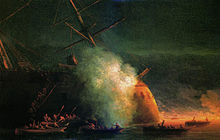Ottoman ironclad Asar-i Şevket
 Line-drawing of the Asar-i Şevket class
| |
| History | |
|---|---|
| Name | Asar-i Şevket |
| Namesake | "Work of God" |
| Ordered | 1866 |
| Builder | Forges et Chantiers de la Gironde |
| Laid down | 1867 |
| Launched | 1868 |
| Commissioned | 3 March 1870 |
| Decommissioned | 1903 |
| Fate | Sold for scrap , 31 July 1909 |
| General characteristics | |
| Class and type | ironclad |
| Displacement | 2,047 metric tons (2,015 long tons; 2,256 short tons) |
| Length | 66.4 m (217 ft 10 in) (loa) |
| Beam | 12.9 m (42 ft 4 in) |
| Draft | 5 m (16 ft 5 in) |
| Installed power |
|
| Propulsion |
|
| Speed | 12 knots (22 km/h; 14 mph) |
| Complement | 170 |
| Armament |
|
| Armor | |
Asar-i Şevket (
The ship saw action in the Russo-Turkish War in 1877–1878, where she supported Ottoman forces in the Caucasus, and later helped to defend the port of Sulina on the Danube. She was laid up for twenty years, until the outbreak of the Greco-Turkish War in 1897, which highlighted the badly deteriorated state of the Ottoman fleet. Asar-i Şevket was not included in the major reconstruction program that saw most of the other ironclads rebuilt after the war, and she was decommissioned in 1903 and broken up for scrap in 1909.
Design
Asar-i Şevket was 66.4 m (217 ft 10 in)
The ship was powered by a single horizontal
Asar-i Şevket was armed with a battery of one 229 mm (9 in)
Service history
Asar-i Şevket, meaning "Work of God",
Upon completion, Asar-i Şevket and the other ironclads then being built in Britain and France were sent to
Russo-Turkish War

The Ottoman fleet began mobilizing in September 1876 to prepare for a conflict with Russia, as tensions with the country had been growing for several years,
In May, Asar-i Şevket, the steam
Later career
After the end of the war in 1878, Asar-i Şevket was
At the start of the
Notes
- ^ a b c d Lyon, p. 389.
- ^ a b c d e Langensiepen & Güleryüz, p. 137.
- ^ Langensiepen & Güleryüz, p. 197.
- ^ Langensiepen & Güleryüz, pp. 3, 137.
- ^ Langensiepen & Güleryüz, pp. 3, 5, 194.
- ^ Sturton, p. 138.
- ^ Langensiepen & Güleryüz, p. 5.
- ^ Langensiepen & Güleryüz, p. 194.
- ^ Greene & Massignani, p. 358.
- ^ Barry, pp. 97–102, 114–115, 190.
- ^ Langensiepen & Güleryüz, p. 6.
- ^ Wilson, pp. 289, 295.
- ^ Stem, pp. 20–21.
- ^ Sturton, pp. 138, 144.
- ^ Langensiepen & Güleryüz, pp. 9–10, 137.
References
- Barry, Quintin (2012). War in the East: A Military History of the Russo-Turkish War 1877–78. Solihull: Helion. ISBN 978-1-907677-11-3.
- Greene, Jack & Massignani, Alessandro (1998). Ironclads at War: The Origin and Development of the Armored Warship, 1854–1891. Pennsylvania: Combined Publishing. ISBN 978-0-938289-58-6.
- Langensiepen, Bernd & Güleryüz, Ahmet (1995). The Ottoman Steam Navy 1828–1923. London: Conway Maritime Press. ISBN 978-0-85177-610-1.
- Lyon, Hugh (1979). "Turkey". In Gardiner, Robert (ed.). Conway's All the World's Fighting Ships 1860–1905. London: Conway Maritime Press. pp. 388–394. ISBN 978-0-85177-133-5.
- Stem, Robert (2008). Destroyer Battles: Epics of Naval Close Combat. Barnsley: Seaforth. ISBN 978-1-4738-1356-4.
- Sturton, Ian. "Through British Eyes: Constantinople Dockyard, the Ottoman Navy, and the Last Ironclad, 1876–1909". Warship International. 57 (2). Toledo: International Naval Research Organization. ISSN 0043-0374.
- OCLC 1111061.
